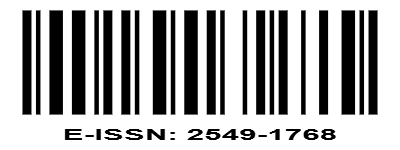SKRINING FITOKIMIA DAN AKTIVITAS ANTIOKSIDAN EKSTRAK ETIL ASETAT CENDAWAN ENDOFIT Aspergillus sp.
DOI:
https://doi.org/10.22373/biotik.v8i2.8194Keywords:
Cendawan endofit, Aspergillus sp., antioksidan, senyawa bioaktif.Abstract
Cendawan endofit telah diketahui menghasilkan banyak senyawa bioaktif salah satunya senyawa antioksidan. Penelitian ini bertujuan untuk mengetahui kandungan fitokimia dan aktivitas antioksidan cendawan endofit Aspergillus sp. secara in vitro dan in vivo. Penentuan aktivitas antioksidan secara in vitro dilakukan dengan metode DPPH. Aktivitas antioksidan secara in vivo dilakukan dengan melihat kemampuannya menurunkan kadar MDA serum darah mencit yang diberi stress oksidatif. Hasil penelitian menunjukkan aktivitas antioksidan Ekstrak etil asetat Aspergillus sp. tergolong sangat kuat dengan IC50 sebesar 38,64, dan mampu menurunkan kadar MDA mencit pada konsentrasi 45 ppm/kgBB. Hasil uji fitokima menunjukkan terdapat kelompok senyawa Flavonoid, Alkaloid, Terpenoid dan Tanin yang dihasilkan dari ekstrak etil asetat cendawan endofit Aspergillus sp.
Downloads
References
Aher, V. D., Wahi, A. kumar, Pawdey, A. M., & Sonawane, A. (2011). Antioxidants as immunomodulator : An expanding research avenue. International Journal of Current Pharmaceutical Research, 3(1), 8–10.
Amarowicz, R. (2007). Tannins: The new natural antioxidants? European Journal of Lipid Science and Technology, 109(6), 549–551. https://doi.org/10.1002/ejlt.200700145
Arora, D. S., & Chandra, P. (2010). Assay of antioxidant potential of two Aspergillus isolates by different methods under various physio-chemical conditions. Brazilian Journal of Microbiology, 41(3), 765–777. https://doi.org/10.1590/S1517-83822010000300029
Aryal, S., Baniya, M. K., Danekhu, K., Kunwar, P., Gurung, R., & Koirala, N. (2019). Total Phenolic content, Flavonoid content and antioxidant potential of wild vegetables from western Nepal. Plants, 8(4). https://doi.org/10.3390/plants8040096
Bhattacharya S. * 1, Debnath S.1, D. P. . and S. A. . (2018). Antioxidant Activity of Fungal Endophyte Aspergillus Sydowii Isolated From International Journal of Current Advanced Research. May. https://doi.org/10.24327/ijcar.2018.11469.1986
Dalimunthe, A., Hasibuan, P. A. Z., Silalahi, J., Sinaga, S. F., & Satria, D. (2018). Antioxidant activity of alkaloid compounds from litsea cubeba lour. Oriental Journal of Chemistry, 34(2), 1149–1152. https://doi.org/10.13005/ojc/340270
De Souza, J. J., Vieira, I. J. C., Rodrigues-Filho, E., & Braz-Filho, R. (2011). Terpenoids from endophytic fungi. Molecules, 16(12), 10604–10618. https://doi.org/10.3390/molecules161210604
Fidrianny, I., Harnovi, M., & Insanu, M. (2014). Evaluation of antioxidant activities from various extracts of sweet orange peels using DPPH, FRAP assays and correlation with phenolic, flavonoid, carotenoid content. Asian Journal of Pharmaceutical and Clinical Research, 7(3), 186–190.
González-Burgos, E., & Gómez-Serranillos, M. P. (2012). Terpene compounds in nature: a review of their potential antioxidant activity. Current medicinal chemistry, 19(31), 5319–5341. https://doi.org/10.2174/092986712803833335
Hartanti, D., Andestia Sinaga, R. Y., Djalil, A. D., & Wahyuningrum, R. (2018). Isolation, identification, phytochemical screening, and antibacterial activity of Aspergillus sp. MFD-01, an endophytic fungus derived from Mesua ferrea. Pharmaciana, 8(2), 338. https://doi.org/10.12928/pharmaciana.v8i2.10009
Kedare, S. B., & Singh, R. P. (2011). Genesis and development of DPPH method of antioxidant assay. Journal of Food Science and Technology, 48(4), 412–422. https://doi.org/10.1007/s13197-011-0251-1
Khajehnasiri, F., Mortazavi, S. B., Allameh, A., Akhondzadeh, S., & Hashemi, H. (2013). Total antioxidant capacity and malondialdehyde in depressive rotational shift workers. Journal of Environmental and Public Health, 2013. https://doi.org/10.1155/2013/150693
Khiralla, A., Mohamed, I., Thomas, J., Mignard, B., Spina, R., Yagi, S., & Laurain-Mattar, D. (2015). A pilot study of antioxidant potential of endophytic fungi from some Sudanese medicinal plants. Asian Pacific Journal of Tropical Medicine, 8(9), 701–704. https://doi.org/10.1016/j.apjtm.2015.07.032
LIPI (Lembaga Ilmu Pengetahuan Indonesia), Uji Aktivitas Antioksidan Kapang Endofit Bo.Ci.Cl.A3 asal Tanaman Kunyit (Curcuma longa Linn) dengan Variasi Nitrogen pada Media Fermentasi. Bogor: LIPI, 2016.
Ludwig-Müller, J. (2015). Plants and endophytes: equal partners in secondary metabolite production? Biotechnology Letters, 37(7), 1325–1334. https://doi.org/10.1007/s10529-015-1814-4
Malešev, D., & Kuntić, V. (2007). Investigation of metal-flavonoid chelates and the determination of flavonoids via metal-flavonoid complexing reactions. Journal of the Serbian Chemical Society, 72(10), 921–939. https://doi.org/10.2298/JSC0710921M
Muawanah, Ahmad, A., & Natsir, H. (2016). Antioxidant activity and toxicity polysaccharide extract from red algae Eucheuma spinosum and Eucheuma cottonii. Marina Chimica Acta, 17(2), 15–23.
Mulianto, N. (2020). Malondialdehid sebagai Penanda Stres Oksidatif pada Berbagai Penyakit Kulit. Cdk-282, 47(1), 1–6.
Nawaz, H., Shad, M. A., Rehman, N., Andaleeb, H., & Ullah, N. (2020). Effect of solvent polarity on extraction yield and antioxidant properties of phytochemicals from bean (Phaseolus vulgaris) seeds. Brazilian Journal of Pharmaceutical Sciences, 56. https://doi.org/10.1590/s2175-97902019000417129
Procházková, D., Boušová, I., & Wilhelmová, N. (2011). Antioxidant and prooxidant properties of flavonoids. Fitoterapia, 82(4), 513–523. https://doi.org/10.1016/j.fitote.2011.01.018
Wahdaningsih, S., & Untari, E. K. (2016). Pengaruh Pemberian Fraksi Metanol Kulit Buah Naga Merah (Hylocerecus polyhizus) Terhadap Kadar Malondialdehid Pada Tikus (Rattus novergicus) Wistar Yang Mengalami Stres Oksidatif. Research Article Nomor, 3(1), 45–55. http://jps.ppjpu.unlam.ac.id/
Wang, J., Yao, L. & Lu, Y. Ceriporia lacerata DMC1106, a new endophytic fungus: Isolation, identification, and optimal medium for 2′,4′-dihydroxy-6′-methoxy-3′,5′-dimethylchalcone production. Biotechnol Bioproc E 18, 669–678 (2013). https://doi.org/10.1007/s12257-012-0846-z
Zaetun, S., Kusuma Dewi, L. B., & Rai Wiyadna, I. B. (2019). Profil Kadar Mda (Malondialdehide) Sebagai Penanda Kerusakan Seluler Akibat Radikal Bebas Pada Tikus Yang Diberikan Air Beroksigen. Jurnal Analis Medika Biosains (JAMBS), 5(2), 79. https://doi.org/10.32807/jambs.v5i2.109
Zhang, Y., Han, T., Ming, Q., Wu, L., Rahman, K., & Qin, L. (2012). Alkaloids produced by endophytic fungi: A review. Natural Product Communications, 7(7), 963–968. https://doi.org/10.1177/1934578x1200700742
Downloads
Published
Issue
Section
License
Authors who publish with BIOTIK: Jurnal Ilmiah Biologi Teknologi dan Kependidikan agree to the following terms:
- Authors retain copyright and grant the journal right of first publication with the work simultaneously licensed under a Creative Commons Attribution License that allows others to share the work with an acknowledgement of the work's authorship and initial publication in this journal.
- Authors are able to enter into separate, additional contractual arrangements for the non-exclusive distribution of the journal's published version of the work (e.g., post it to an institutional repository or publish it in a book), with an acknowledgement of its initial publication in this journal.
- Authors are permitted and encouraged to post their work online (e.g., in institutional repositories or on their website) prior to and during the submission process, as it can lead to productive exchanges, as well as earlier and greater citation of published work.











